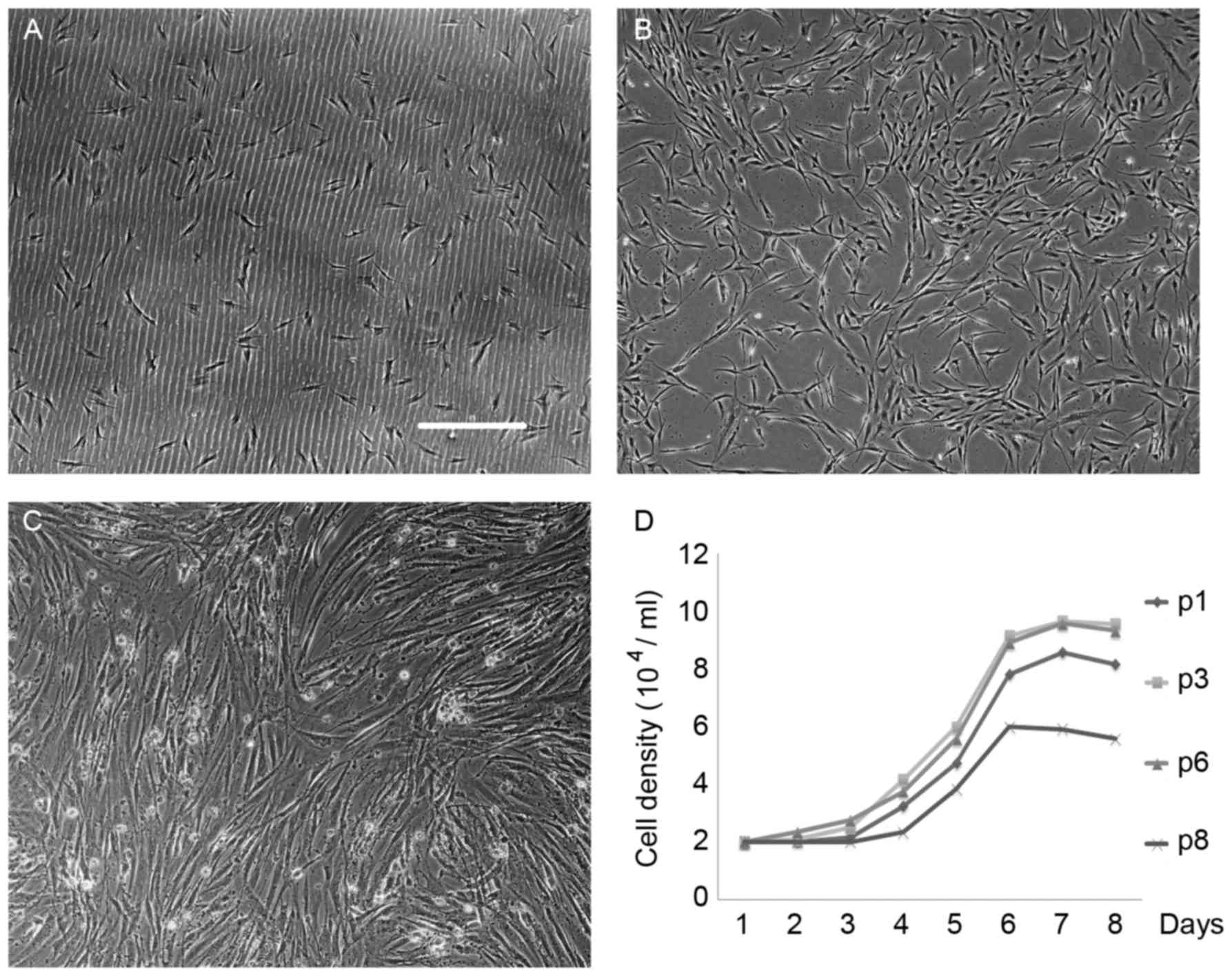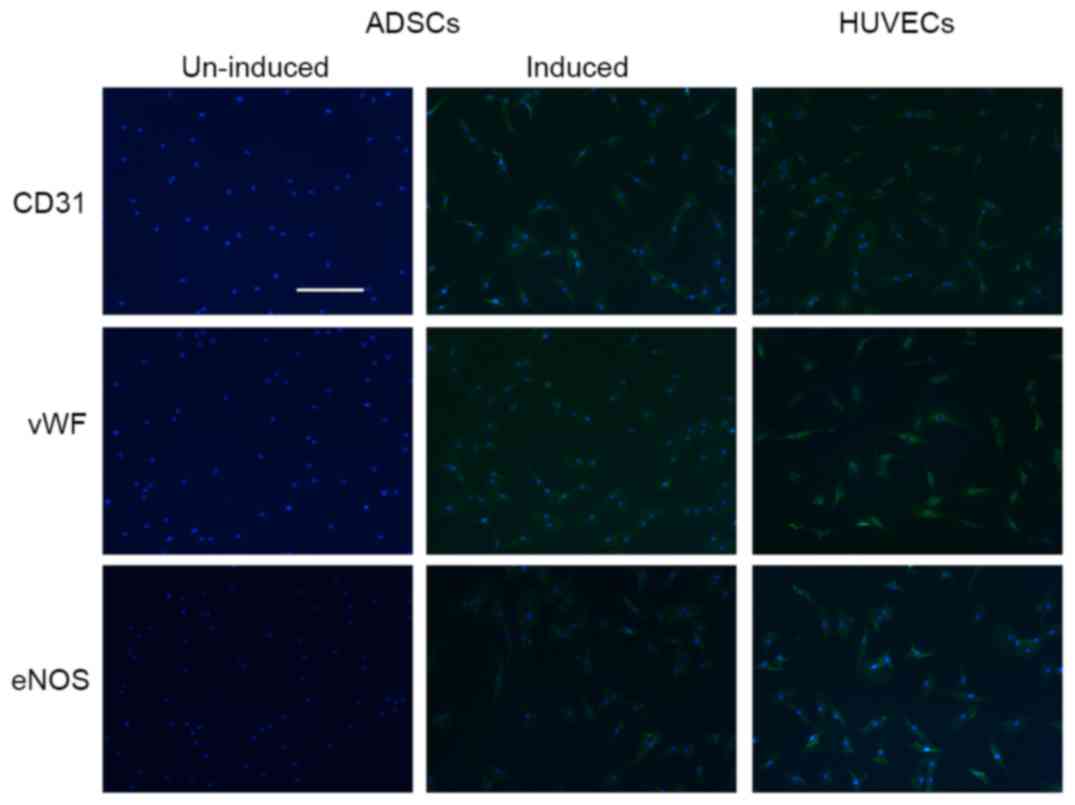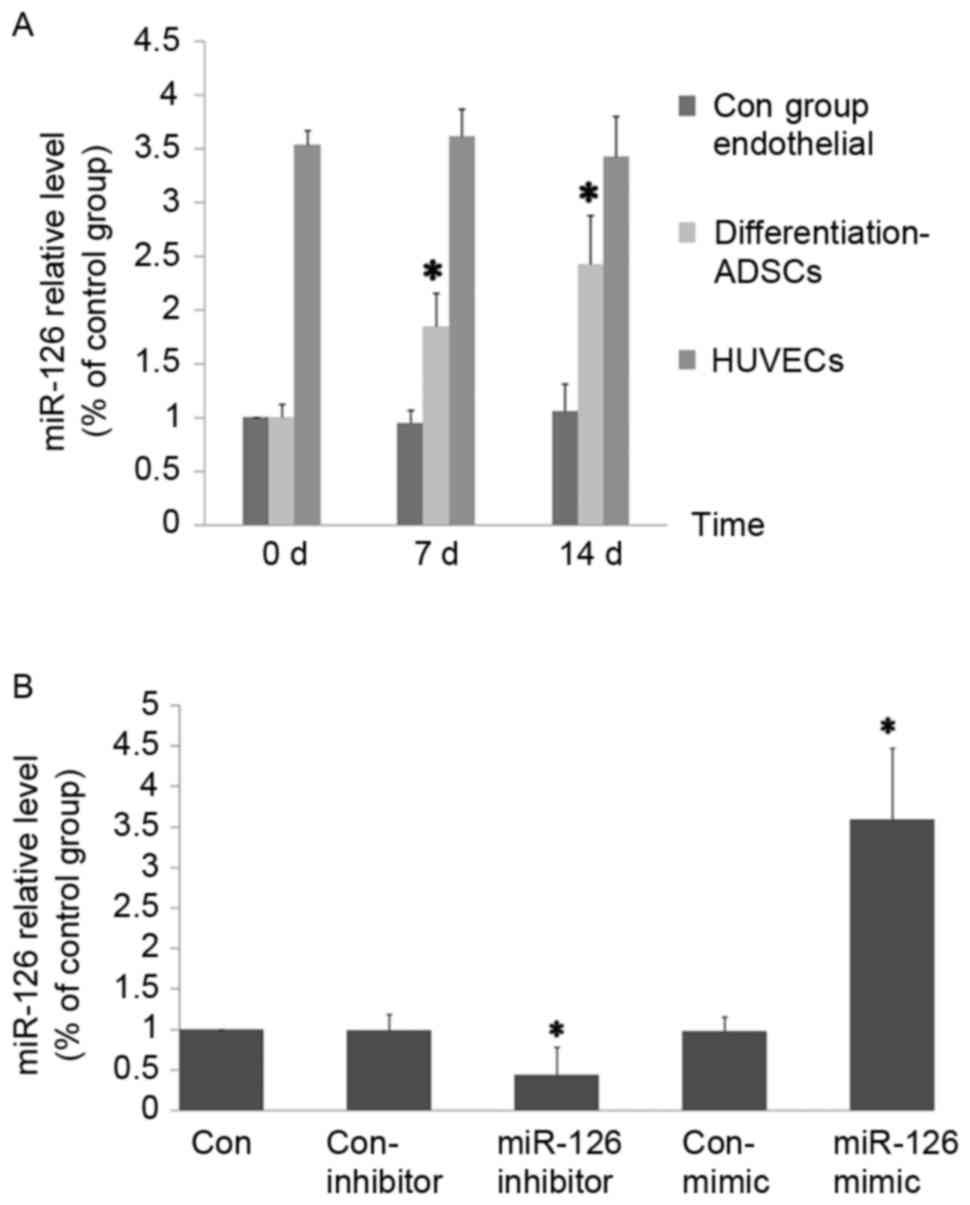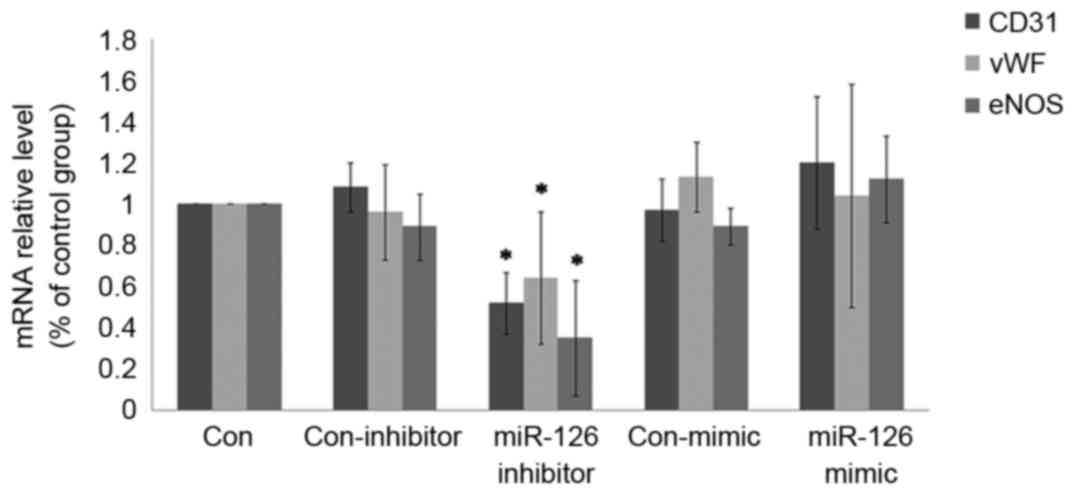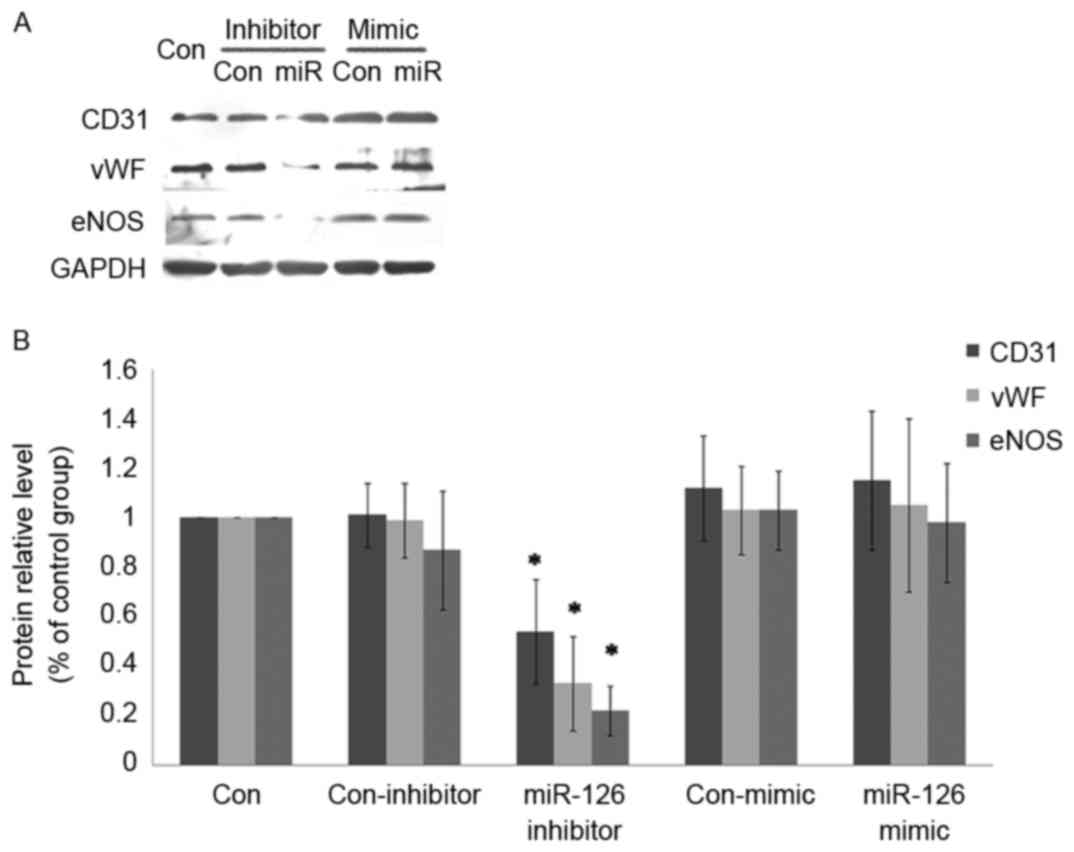miR‑126 is essential for endothelial phenotype expression during endothelial differentiation in adipose‑derived stem cells
- Authors:
- Published online on: October 27, 2017 https://doi.org/10.3892/mmr.2017.7915
- Pages: 442-446
Abstract
Introduction
Due to the rapid development of stem cell transplantation in preclinical research and clinical trials over the last decade, stem cell replacement therapies have become modern therapeutic approaches (1). Similar to bone-marrow stromal cells, adipose-derived stem cells (ADSCs) have the ability to differentiate into various types of cell lineage, including adipogenic, osteogenic, myogenic and chondrogenic cells (2,3). In addition, the yield of mesenchymal stem cells (MSCs) from adipose tissue is 100–500 fold that from bone marrow (4). The unique biology of autologous ADSCs, including being easily expanded, immune-privileged and capable of long-term transgene expression following multiple stages of differentiation, demonstrates their potential as a gene delivery vehicle (5–7).
The endothelial differentiation of ADSCs serves an essential role in vascular development, function and disease (8). Numerous peptide growth factors promote angiogenesis by promoting differentiation, and enhancing endothelial cell proliferation, migration and capillary network stability (9).
The knockdown of microRNA-126 (miR-126) in zebrafish in vivo resulted in the loss of vascular integrity and hemorrhage during embryonic development, and targeted deletion of miR-126 in mice caused delayed angiogenic sprouting, widespread hemorrhaging and partial embryonic lethality (10–12). These vascular abnormalities may be attributed to diminished angiogenic growth factor signaling, resulting in reduced endothelial cell differentiation, growth, sprouting and adhesion (13–16). This evidence indicates that miR-126 may be involved in multiple aspects of fundamental biological processes, including angiogenesis. However, the role of miR-126 in mediating the differentiation of ADSCs to endothelial cells has not been demonstrated.
The present study focused on the association between miR-126 and the endothelial differentiation of ADSCs.
Materials and methods
Cell growth curve and endothelial differentiation of ADSCs
ADSCs were purchased from the American Type Culture Collection (Manassas, VA, USA) and cultured in α-Minimum Essential Medium (α-MEM; Gibco; Thermo Fisher Scientific, Inc., Waltham, MA, USA), supplemented with 10% fetal bovine serum (Gibco; Thermo Fisher Scientific, Inc.) at 37°C in 5% CO2. Equal numbers (2×104) of passage (p)1, 3, 6 and 8 cells were plated and cultured. Cells images were obtained at ×100 magnification using a phase-contrast inverted light microscope. Cells were harvested each day for 8 days. The total number of cells was counted in each plate using a hemocytometer. The cell growth curve was drawn by plotting the mean cell number of each plate against the culture time. For endothelial differentiation, ADSCs were cultured in Endothelial Cell Growth Medium-2 (EGM-2; Lonza, Basel, Switzerland). Human umbilical vein endothelial cells (HUVECs; CRL-1730; American Type Culture Collection) were cultured in F-12K medium (30–2004; American Type Culture Collection) with 10% fetal bovine serum (30–2020; American Type Culture Collection), 0.05 mg/ml ECGS (no. 354006, BD Biosciences, Franklin Lakes, NJ, USA) and 0.1 mg/ml heparin (#H3393; Sigma-Aldrich, Merck KGaA, Darmstadt, Germany).
Transfection
The hsa-miR-126-3p inhibitor (CGC AUU AUU ACU CAC GGU ACGA), hsa-miR-126-3p mimic (5–3′, UCG UAC CGU GAG UAA UAA UGCG; 3–5′, AGC AUG GCA CUC AUU AUU ACGC;), and their negative controls (NCs) (mimic NC, 5–3′, UCA CAA CCU CCU AGA AAG AGU AGA; 3–5′, AGU GUU GGA GGA UCU UUC UCA UCU; inhibitor NC, UCU ACU CUU UCU AGG AGG UUG UGA; all Biomics Biotechnologies, Nantong, China) were diluted to a final concentration of 50 nM with RNase-free H2O. ADSCs were transfected respectively with these oligonucleotides using Lipofectamine 2000 (Invitrogen; Thermo Fisher Scientific, Inc.), following the manufacturer's protocol. At each time point (days 1–8), cells were harvested for further analysis. The efficiency of transfection was determined using aCy3-short interfering RNA (Cy3-siRNA) transfection control (Biomics Biotechnologies). The inhibition and overexpression efficiencies were determined by comparing with the NCs.
Immunofluorescence staining
Cells were uninduced in α-MEM or induced in EGM-2 for 7–14 days, fixed with 4% paraformaldehyde (PFA), blocked with 10% normal goat serum (50062Z; Thermo Fisher Scientific, Inc.) for 10 min at room temperature and incubated with one of three primary antibodies: Rabbit anti-human cluster of differentiation (CD)31 (1:50; 11265-AP), von Willebrand factor (vWF) (1:50; 11778-1-AP) or endothelial nitric oxide synthase (eNOS) (1:50; 20116-1-AP) (all from Proteintech Group, Inc., Chicago, IL, USA) at 4°C overnight. Following incubation with fluorescein isothiocyanate (FITC)-conjugated goat anti-rabbit IgG (CW0114S, 1:100; CWBiotech, Beijing, China) for 3 h at room temperature, the cells were counterstained by incubation with DAPI (Sigma-Aldrich, Merck KGaA). Images were obtained at magnification ×200 using a phase contrast fluorescence microscope (Olympus Corporation, Tokyo, Japan).
Reverse transcription-quantitative polymerase chain reaction (RT-qPCR)
Total RNA and miRNA were isolated using a miRNeasy Mini kit (Qiagen, Inc., Valencia, CA, USA). Synthesis of complementary DNA from mRNA and miRNA was performed using a PrimeScript RT reagent kit (Takara Bio, Inc., Otsu, Japan) or a miRcute miRNA First-Strand cDNA Synthesis kit (Tiangen Biotech Co., Ltd., Beijing, China), respectively. RT-qPCR analysis of mRNA and miRNA was performed using SYBR Premix Ex Taq™ (Takara Bio, Inc.) or a miRcute miRNA qPCR Detection kit (SYBR Green) (Tiangen Biotech Co., Ltd.), respectively. Amplification data was recorded using an ABI 7500 Real-Time PCR System (Applied Biosystems; Thermo Fisher Scientific, Inc.). The PCR analysis of miR-126 consisted of 38 cycles of 95°C for 15 sec and 60°C for 1 min, following an initial denaturation step of 95°C for 10 min. The expression level of miR-126 was normalized to U6 small nuclear RNA, and the expression levels of CD31, vWF and eNOS mRNA were normalized to GAPDH. The primers used are presented in Table I. The results were subjected to melting curve analysis, and the data were analyzed using the 2−ΔΔCq method (17).
Western blot analysis
Confluent cells were removed by scraping, lysed in mammalian protein extraction reagent (Thermo Fisher Scientific, Inc.) supplemented with the protease inhibitor phenylmethylsulfonyl fluoride, and quantified using a bicinchoninic acid assay. Proteins (20 µg/lane) were resolved on a 10% SDS-PAGE gel and transferred onto a polyvinylidene fluoride membrane. Following blocking in 5% non-fat dried milk and TBS with 0.1% Tween-20 (TBST) for 2 h, the blots were incubated with a rabbit anti-human CD31 (1:500; 11265-AP), vWF (1:500; 11778-1-AP) or eNOS (1:500; 20116-1-AP) (all from ABclonal Biotech Co., Ltd., Cambridge, MA, USA) overnight at 4°C. GAPDH (1:3,000; sc-47724; Santa Cruz Biotechnology, Inc., Dallas, TX, USA) was used as an internal control. Subsequent to washing with TBST, the blots were incubated with HRP-conjugated goat anti-rabbit IgG (CW0103S, 1:2,000; CWBiotech) at room temperature for 1 h and visualized by enhanced chemiluminescence (GE Health care Biosciences, Pittsburgh, PA, USA). Image band area and density were estimated using Quantity One 4.6.2 (Bio-Rad Laboratories Inc., Hercules, CA, USA).
Statistical analysis
Each experiment was repeated three times independently. All data were expressed as the mean ± standard deviation. Statistical analysis was performed using a one-way analysis of variance test and SPSS software (version 19.0; IBM SPSS, Armonk, NY, USA). P<0.05 was considered to indicate a statistically significant difference.
Results
Morphological features of cultured ADSCs
The ADSCs attached to the culture dish surface exhibited a typical fibroblast-like morphology. The cells were maintained in culture with no sign of senescence or differentiation following repeated subculturing to p6 (Fig. 1A-C). In order to investigate whether passages affect cell growth, the number of cells was recorded every day for 8 days and compared with the cell growth curve of p1, 3, 6 and 8. Following an initial lag or stationary period (day 1), the cells expanded rapidly in a logarithmic manner until a plateau was reached (day 6). However, the ADSCs exhibited markedly more rapid growth at p3 and 6 (Fig. 1D).
Endothelial phenotype during endothelial differentiation in ADSCs
ADSCs were subjected to incubation in EGM-2 to stimulate endothelial differentiation. When cultured in medium with endothelial cell growth supplement, ADSCs expressed endothelial-specific markers, including CD31, vWF and eNOS (Fig. 2). These endothelial markers were rapidly upregulated during differentiation and remained elevated 14 days post-differentiation (data not shown).
Differential expression of miR-126 during endothelial differentiation of ADSCs
The non-induced and endothelial-induced ADSCs were harvested on days 0, 7 and 14, and analyzed for miR-126 level using RT-qPCR analysis, to determine the expression of miR-126 at the different stages of endothelial differentiation. It was identified that the expression of miR-126 was enriched in HUVECs and markedly increased during the endothelial differentiation of ADSCs in a time-dependent manner (Fig. 3A).
Transfection of ADSCs
In order to study the effect of miR-126 in the endothelial differentiation of ADSCs, a miR-126 overexpression and inhibition model was established. After 24 h, transfection efficiency was detected by Cy3-siRNA transfection control (siR-Rib). Following transfection with miR-126 mimic or inhibitor for 3 days, the expression of miR-126 was detected to assess the efficiency of overexpression and inhibition (Fig. 3B).
miR-126 modulates the endothelial phenotype of ADSCs
The expression of CD31, vWF and eNOS largely mirrored that of endothelial markers during endothelialization. The expression of these markers was decreased by miR-126 inhibitor transfection during endothelial differentiation at the mRNA (Fig. 4) and protein level (Fig. 5). In addition, ADSCs with miR-126 overexpression were generated through transfection of a miR-126 mimic. It was identified that the expression of endothelial markers was not notably affected by miR-126 overexpression.
Discussion
ADSCs may be easily harvested from lipoaspirate and the extraction maybe less invasive and less expensive compared with extraction from bone marrow. Additionally, ADSCs have a significantly shorter doubling time when expanded in vitro (18). In the present study, ADSCs of p3-6were used for the experiments and it was observed that the majority of the cells exhibited typical fibroblastoid morphology, expressed MSC surface markers, and demonstrated the capability for multipotency (data not shown). These intrinsic characteristics and advantages make ADSCs an ideal stem cell source for the present study and future cell-based tissue engineering and therapies (19,20).
In the present study, expression analyses revealed an abundant level of miR-126 in HUVECs and identified miR-126 as one of the miRs known to be specifically expressed in the endothelial cell lineage. Expression of miR-126 gradually increased during ADSC endothelial differentiation, and expression was marked when endothelial markers were expressed. Endothelial differentiation markers (CD31, vWF and eNOS) were used to evaluate the differentiation capability of ADSCs. The results of the present study suggest that miR-126 may be involved in the directional differentiation of ADSCs into vascular endothelial cells, and may promote the progress of the differentiation.
Due to the high expression of miR-126 in HUVECs, and the increased expression during the endothelial differentiation of ADSCs, the potential role of this miR in the regulation of differentiation towards the endothelial lineage was investigated. In order to confirm the role of miR-126 in the endothelial differentiation of ADSCs, down- and up-regulation of miR-126 expression was achieved through transfection withmiR-126 inhibitor and mimic, respectively. As a result of miR-126 inhibition in ADSCs undergoing the endothelial differentiation, diminished mRNA expression of endothelial cell markers was observed. These results demonstrated that the downregulation of miR-126 may exhibit a negative effect on endothelial differentiation. By contrast, the overexpression of miR-126 did not improve the expression levels of endothelial markers. The results of the present study suggest that while miR-126 is enriched in vascular endothelial cells, and is essential to endothelial differentiation, it is not sufficient to promote the differentiation of ADSCs towards an endothelial phenotype.
Previous research has demonstrated that miR-126 serves an essential role in stem cell differentiation (21) and angiogenesis. However, the mechanism remains unknown and there is a lack of consistency between studies. It is difficult to connect the physiological functions of miR-126 in vasculature to its functions in tumor. It has been established that angiogenesis represents one of the key features in the pathogenesis of cancer (22), but little is known about the role of miR-126 in tumor neoangiogenesis. The present study suggests that miR-126 may have a supportive role in the progression of cancer, which maybe mediated by the promotion of blood vessel growth. By contrast, it was reported that the downregulation of miR-126 increased the activity of vascular endothelial growth factor-A in lung and breast cancer (23–25). miR-126 is regarded as a putative tumor suppressor due to its potential role in anti-angiogenesis in cancer (26). Consequently, miR-126 may function differently in stromal cells compared with tumor cells. The effect and mechanism of miR-126 on angiogenesis in different cells or tissue requires further research, to compare the effects of miR-126 in tumor cells with the functions of miR-126 in tumor vasculature and the surrounding vessels of the tumor periphery.
Acknowledgements
The present study was supported by a grant from the National Natural Science Foundation of China (grant no. 81200443).
References
|
Trounson A and McDonald C: Stem Cell Therapies in Clinical Trials: Progress and Challenges. Cell Stem Cell. 17:11–22. 2015. View Article : Google Scholar : PubMed/NCBI | |
|
Yang Y, Chen XH, Li FG, Chen YX, Gu LQ, Zhu JK and Li P: In vitro induction of human adipose-derived stem cells into lymphatic endothelial-like cells. Cell Reprogram. 17:69–76. 2015. View Article : Google Scholar : PubMed/NCBI | |
|
Hu F, Wang X, Liang G, Lv L, Zhu Y, Sun B and Xiao Z: Effects of epidermal growth factor and basic fibroblast growth factor on the proliferation and osteogenic and neural differentiation of adipose-derived stem cells. Cell Reprogram. 15:224–232. 2013.PubMed/NCBI | |
|
De Ugarte DA, Morizono K, Elbarbary A, Alfonso Z, Zuk PA, Zhu M, Dragoo JL, Ashjian P, Thomas B, Benhaim P, et al: Comparison of multi-lineage cells from human adipose tissue and bone marrow. Cells Tissues Organs. 174:101–109. 2003. View Article : Google Scholar : PubMed/NCBI | |
|
Ikegame Y, Yamashita K, Hayashi S, Mizuno H, Tawada M, You F, Yamada K, Tanaka Y, Egashira Y, Nakashima S, et al: Comparison of mesenchymal stem cells from adipose tissue and bone marrow for ischemic stroke therapy. Cytotherapy. 13:675–685. 2011. View Article : Google Scholar : PubMed/NCBI | |
|
Locke M, Feisst V and Dunbar PR: Concise review: Human adipose-derived stem cells: Separating promise from clinical need. Stem Cells. 29:404–411. 2011. View Article : Google Scholar : PubMed/NCBI | |
|
Khan WS, Adesida AB, Tew SR, Longo UG and Hardingham TE: Fat pad-derived mesenchymal stem cells as a potential source for cell-based adipose tissue repair strategies. Cell Prolif. 45:111–120. 2012. View Article : Google Scholar : PubMed/NCBI | |
|
Fraser JK, Wulur I, Alfonso Z and Hedrick MH: Fat tissue: An underappreciated source of stem cells for biotechnology. Trends Biotechnol. 24:150–154. 2006. View Article : Google Scholar : PubMed/NCBI | |
|
Park IS, Rhie JW and Kim SH: A novel three-dimensional adipose-derived stem cell cluster for vascular regeneration in ischemic tissue. Cytotherapy. 16:508–522. 2014. View Article : Google Scholar : PubMed/NCBI | |
|
Fish JE, Santoro MM, Morton SU, Yu S, Yeh RF, Wythe JD, Ivey KN, Bruneau BG, Stainier DY and Srivastava D: miR-126 regulates angiogenic signaling and vascular integrity. Dev Cell. 15:272–284. 2008. View Article : Google Scholar : PubMed/NCBI | |
|
Wang S, Aurora AB, Johnson BA, Qi X, McAnally J, Hill JA, Richardson JA, Bassel-Duby R and Olson EN: The endothelial-specific microRNA miR-126 governs vascular integrity and angiogenesis. Dev Cell. 15:261–271. 2008. View Article : Google Scholar : PubMed/NCBI | |
|
Kuhnert F, Mancuso MR, Hampton J, Stankunas K, Asano T, Chen CZ and Kuo CJ: Attribution of vascular phenotypes of the murine Egfl7 locus to the microRNA miR-126. Development. 135:3989–3993. 2008. View Article : Google Scholar : PubMed/NCBI | |
|
Sasahira T, Kurihara M, Bhawal UK, Ueda N, Shimomoto T, Yamamoto K, Kirita T and Kuniyasu H: Downregulation of miR-126 induces angiogenesis and lymphangiogenesis by activation of VEGF-A in oral cancer. Br J Cancer. 107:700–706. 2012. View Article : Google Scholar : PubMed/NCBI | |
|
Nowak WN, Florczyk U, Józkowicz A and Dulak J: Role of microRNA in endothelial cells-regulation of differentiation and angiogenesis. Postepy Biochem. 59:405–414. 2013.(In Polish). PubMed/NCBI | |
|
Yan T, Liu Y, Cui K, Hu B, Wang F and Zou L: MicroRNA-126 regulates EPCs function: Implications for a role of miR-126 in preeclampsia. J Cell Biochem. 114:2148–2159. 2013. View Article : Google Scholar : PubMed/NCBI | |
|
Meister J and Schmidt MH: miR-126 and miR-126*: New players in cancer. ScientificWorldJournal. 10:2090–2100. 2010. View Article : Google Scholar : PubMed/NCBI | |
|
Livak KJ and Schmittgen TD: Analysis of relative gene expression data using real-time quantitative PCR and the 2(-Delta Delta C(T)) method. Methods. 25:402–408. 2001. View Article : Google Scholar : PubMed/NCBI | |
|
Ikegame Y, Yamashita K, Hayashi S, Mizuno H, Tawada M, You F, Yamada K, Tanaka Y, Egashira Y, Nakashima S, et al: Comparison of mesenchymal stem cells from adiposetissue and bonemarrow for ischemicstroke therapy. Cytotherapy. 13:675–685. 2011. View Article : Google Scholar : PubMed/NCBI | |
|
Nakagami H, Maeda K, Morishita R, Iguchi S, Nishikawa T, Takami Y, Kikuchi Y, Saito Y, Tamai K, Ogihara T and Kaneda Y: Novel autologous cell therapy in ischemic limb disease through growth factor secretion by cultured adipose tissue-derived stromal cells. Arterioscler Thromb Vasc Biol. 25:2542–2547. 2005. View Article : Google Scholar : PubMed/NCBI | |
|
Su SJ, Yeh YT, Su SH, Chang KL, Shyu HW, Chen KM and Yeh H: Biochanin a promotes osteogenic but inhibits adipogenic differentiation: Evidence with primary adipose-derived stem cells. Evid Based Complement Alternat Med. 2013:8460392013. View Article : Google Scholar : PubMed/NCBI | |
|
Wu Z, Yin H, Liu T, Yan W, Li Z, Chen J, Chen H, Wang T, Jiang Z, Zhou W and Xiao J: MiR-126-5p regulates osteoclast differentiation and bone resorption in giant cell tumor through inhibition of MMP-13. Biochem Biophys Res Commun. 443:944–949. 2014. View Article : Google Scholar : PubMed/NCBI | |
|
El-Kenawi AE and El-Remessy AB: Angiogenesis inhibitors in cancer therapy: Mechanistic perspective on classification and treatment rationales. Br J Pharmacol. 170:712–729. 2013. View Article : Google Scholar : PubMed/NCBI | |
|
Liu B, Peng XC, Zheng XL, Wang J and Qin YW: MiR-126 restoration down-regulate VEGF and inhibit the growth of lung cancer cell lines in vitro and in vivo. Lung Cancer. 66:169–175. 2009. View Article : Google Scholar : PubMed/NCBI | |
|
Zhu X, Li H, Long L, Hui L, Chen H, Wang X, Shen H and Xu W: miR-126 enhances the sensitivity of non-small cell lung cancer cells to anticancer agents by targeting vascular endothelial growth factor A. Acta Biochim Biophys Sin (Shanghai). 44:519–526. 2012. View Article : Google Scholar : PubMed/NCBI | |
|
Zhu N, Zhang D, Xie H, Zhou Z, Chen H, Hu T, Bai Y, Shen Y, Yuan W, Jing Q and Qin Y: Endothelial-specific intron-derived miR-126 is down-regulated in human breast cancer and targets both VEGFA and PIK3R2. Mol Cell Biochem. 351:157–164. 2011. View Article : Google Scholar : PubMed/NCBI | |
|
Feng R, Chen X, Yu Y, Su L, Yu B, Li J, Cai Q, Yan M, Liu B and Zhu Z: miR-126 functions as a tumour suppressor in human gastric cancer. Cancer Lett. 298:50–63. 2010. View Article : Google Scholar : PubMed/NCBI |



